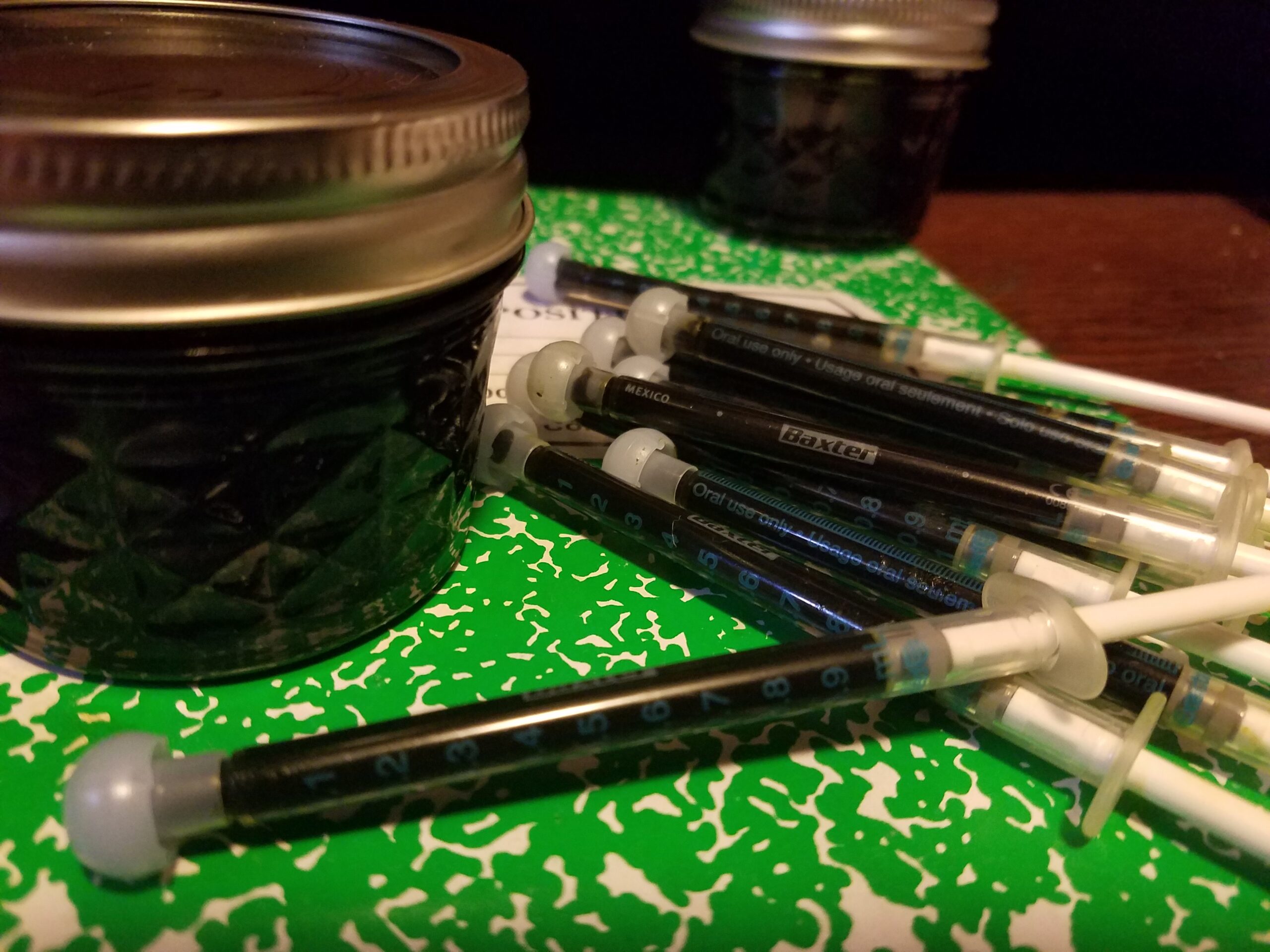Notes to Consider
This article was first published February 17th, 2018 in the Medical Cannabis Journal.
These notes are to help bring clarity as we consider the reasonable needs of the average Colorado Caregiver and those who produce cannabis oil, often referred to as FECO, (full extract cannabis oil) that can be produced safely with a food grade alcohol extraction method.
Making careful note that most Caregivers are in themselves a patient, their personal meds should NEVER be weighed in when calculating Caregiver product possession amounts. That should be commonly understood.
For this paper, estimations are quite general. Different strains produce different amounts of resin. Unless otherwise stated, estimations are based on “home” production as would be characteristic of a Caregiver.
We need to examine our motives when designing policy regarding Cannabis. For the chronically and terminally ill, Cannabis concentrate is not “contraband” or a “harmful, dangerous drug”. Those who could benefit from Cannabis therapy, particularly those afflicted with cancer, amass a wide span of America’s population, touching on literally every family in the nation.
It is time to lay to rest the bigotries that have previously guided our judgements regarding Cannabis. We must guard the welfare of our most vulnerable, and guard the treatments that champion their quality of life.
Sativa or Indica
High THC Indica cultivars are preferred for cancer issues. They are more resinous though the plants do not characteristically get very big. Home grown, indoor indica plants can produce anywhere from three to six ounces at harvest on the average, far less than the Sativa plants that are preferred by recreational users.
THC is sought in it’s greatest concentrations when dealing with cancer. Percentages can range from 10 to 25% THC in flower, while reaching 45 to 85% as a concentrate. The greater the percentage, the quicker and more responsive the affliction is to treatment. Stands to reason.
CBD cultivars have been found to be effective with pain in some cases and with some forms of seizure disorder. Understandably, CBD can often be useful in adjunct to high THC cancer treatments to help mitigate the side effects of chemo therapy, namely muscle ache and neuropathy.
In most cases, THC is still required to open CB1 receptors. THC most accurately replicates the work of our endogenous cannabinoid, Anandamide.
Strains high in CBD are not characteristically as resinous, requiring greater amounts of plant material when producing oil. If a patient requires both THC and CBD, overall quantities of flower and oil may need to be adjusted accordingly.
Working Together
To ensure optimum thriftiness and effectiveness, Caregivers, patients and growers should be allowed to barter and sell among themselves, thus addressing redundancy and overgrows while providing the medium for benevolent outreach.
Seizures by law enforcement must NEVER be destroyed. Instead, “contraband” can be processed and afforded to the poor who are without the means to appreciate Cannabis therapies.
Stockpiling
In every case, it is crucial that patients and caregivers are able to stockpile their Cannabis. That way, they can ensure an affordable and uninterruptible supply of their medicine that does not rely on other forms of compensation or periods of lack. It’s why farmers have barns and silos.
Cannabis is vital medicine. Particularly for those dealing with otherwise terminal issues, periods of lack equate to suffering and even death.
Cannabis Flower
A pound of quality cannabis flower (which includes the whole plant, flowers AND leaf) can produce upwards of 60 grams of cannabis oil when properly processed. Lesser cultivars may produce measurably less.
In a perfect world, all oil would be made from flower. Unfortunately, even most dispensaries use trim to produce their concentrates. The few that produce FECO (full extract cannabis oil) most certainly use trim. Their more potent material goes to products that demand a higher profit. This means that patients all too often are forced to settle for an inferior product to treat their chronic or terminal illness.
Cannabis oil, most particularly FECO that has been prepared at home with inexpensive equipment, does not taste good smoked, nor does it produce the effects preferred by the recreational user. Medicinal oils are generally sought to be healing, sedative and soothing – exactly what would be preferred by someone effected by chronic or terminal illness.
Trim
Trim is most available for the oil making process, and generally more affordable to the average patient. Trim is the small and big leaf that is removed with the stem. It is usually devoid of the flowers.
Though bulky by nature, it requires far more to strike the same weight as flower. When processing trim, it can require as much as two to three pounds to produce a 60 gram oil run. If multiple patients are being serviced at the same time (and it’s most cost effective to do so), it is conceivable to imagine a Caregiver having ten to fifteen pounds in their possession in different levels of processing, even when addressing the need of as little as five people.
In making cannabis oil, it is NEVER cost effective to process in runs smaller than a half pound. Temperature variance and the inability to control “hot spots“ in most cooking apparatuses, usually escalates a 20 to 50 percent loss of final product due to scorching, etc.
The amount of alcohol required is flexible among different oil cooks. Most flush their plant material two to three times to ensure that they have stripped the optimum amount of resin. A large volume of alcohol does not necessarily equate to a large amount of concentrate, (i.e. multiple flushes of the same material).
A half gallon of “dragon” (tincture) in process may only produce three to five grams of oil.
Apparatuses, such as water purifiers, like the “Green Oil Machine” are often used to ensure that the optimum amount of alcohol is removed and not released to the atmosphere. Careful cooks can recycle as much as 90% of their food grade alcohol. 90% reclaim of alcohol means only 10% has been released to atmosphere, making for a far safer process.
Safety and reasonable affordability should be admired, not chastised.
Most of these devises require a minimum of a half gallon of liquid per run.
Cannabis Oil: The process
Making cannabis oil at home is in effect cooking. Cannabis, in all respects is food. Cannabis historically has been food and medicine for the human race for over 25,000 years. Science has proven overwhelmingly that cannabis, whether in flower or in oil, is non-toxic.
The process of producing cannabis oil is age old. The generally used method is not unlike extraction methods used with other essential oils like lavender. There is a world of variations but the process is basically the same.
- The cannabis is ground
- Placed in vessels (mason jars)
- Immersed in food grade alcohol
- The solution is agitated to thoroughly saturate all the plant material
- The solution (dirty dragon) is strained to remove large plant material
- The solution is filtered to remove small plant material
- The filtered solution (clean dragon) is boiled at low temperature to remove alcohol and water solubles
In cancer treatments, as well as other chronic, life threatening conditions, different methods of administration are found effective with different symptoms and infections.
Suspensions in olive or cold pressed hemp seed oil can provide the means to address measured dosages as low as 2mg.
Likewise, for suppository dosing, coconut oil can be measured in liquid form, while hardened in a freezer to prepare for application.
Most patients battling stage 4 cancers, when affordably possible, consume a combination of oral and suppository regiments, augmented with vaporizing of flower or concentrate (other than FECO) for breakout issues.
Regular applications of “salve” (Cannabis infused topical lotion) can be effective for treating neuropathy and general body aches that often accompany chemotherapy treatments.
Cannabis salves can also bring pain relief from conditions such as arthritis and Fibromyalgia through topical administration.
A two ounce container of infused coconut salve can contain upwards of a gram of cannabis oil.
Cannabis oil can be used to provide measured “dosing” in other applications like edibles or regular cooking. When regularly introduced with other foods, and in gradually increasing dosages, the human body can quickly adjust minimizing fatigue and euphoric effects.
In all these varied applications, it is absolutely necessary to stay cognizant of the accumulative amounts of plant material and concentrate that would be required for the regular daily needs of the average chronically ill cannabis patient, not to mention those patients battling terminal illness. The numbers can be quite striking, but MUST be soberly considered so as not to place the chronically ill cannabis patient in jeopardy of prosecution from overly exuberant law enforcement.
Add it up. For a cancer patient…conceivably, at any given time:
30 to 60g of Cannabis oil, THC rich
30 to 60g of Cannabis oil, CBD rich
5 to 10g of Cannabis oil infused suppositories (up to 50 doses or more)
8 to 32g of Cannabis oil infused into oral suspension
2 to 4g of Cannabis oil infused into topical salve.
That’s upwards of 166 grams for one patient…and it doesn’t even account for flower (upwards of 2 ounces, or another 56 grams).
Not taking into account that a fifty year old grandmother with cancer might also stop into a dispensary and pick up some infused gummies to sooth her chemo-ravaged belly.
First and foremost, in our “efforts to protect society”, we must also afford protection for the patient for whom medical Cannabis programs were initially created.
We never in our wildest dreams could have imagined that the results of Cannabis therapies could be as far-reaching and seemingly miraculous as we have experienced. Children’s lives are being extend, and, in some cases, preserved. Those battling terminal illness are finding new hope.
Please do not forsake Colorado’s caregivers and the richness they bring to the hopeless. Please join me in not only ensuring their survival, but also in giving them the security and materials they so desperately need to aid our less fortunate.
Cannabis is nontoxic. Cannabis is food. Cannabis is the single most important medicine of the 21st century.










